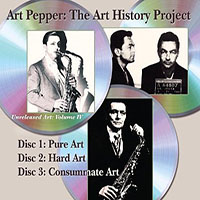Home » Jazz Articles » Album Review » Art Pepper: The Art History Project
Art Pepper: The Art History Project
This three-disc compilation is the fourth in a series of releases curated by Pepper's widow, Laurie. The first three releases dealt with unreleased materials from the altoist's live dates in Croydon, UK 1981, Abashiri, Japan 1981, and Washington D.C 1982. Like the utterly amazing nine-CD Complete Village Vanguard Sessions (Contemporary, 1995) from 1977, these live dates display a chapped and leathery Pepper bearing his battered soul for audiences.
For her fourth edition, Laurie Pepper steps back from the end of her husband's life to survey the evolution of his sound, and the decline and redemption of his person. Those two things, unfortunately traveled hand-in-hand. With materials both released and unreleased. She presents the altoist from his tenure with Stan Kenton's Innovations Orchestra, playing Shorty Rogers' "Art Pepper" before moving into smaller group sessions where he could display his brilliant, dexterous playing.
"Fascinatin' Rhythm" is clean and crisp, and his original ballad "Patricia" is quite brave in its patience, coming from a young, yet seasoned player. On the first disc, Pure Art (1951-1960), Pepper is a player very much influenced by the bebop revolution of Charlie Parker and Dizzy Gillespie. Although he is tugged towards beboppers,west coast players like Teddy Edwards and Wardell Gray had some influence on his sound. Fans who only know his comeback recordings of the 1970s and '80s may have a difficult time recognizing Pepper here, but a closer inspection reveals hints of the expression to come.
Leaving his San Quentin prison story to the biographers, the period after his release in the mid-1960s is documented on Hard Art (1960-1968), with mostly unreleased music. A session for Contemporary, featuring pianist Steve Strazzeri, bassist Hersh Hammel and drummer Bill Goodwin, was deemed unworthy of release by producer Les Koenig. Just a few years prior, Koenig was producing Ornette Coleman's first recordings, but here he could not hear Pepper's blossoming expression; these six tracks (four songs and two talking rehearsals) are the hidden gems linking 1950s Pepper to the rawer genius of the 1970s and '80s. Pepper jettisons slick glamour for the more familiar and expressive sound of the last period in his life's work.
The third disc, Consummate Art (1972-1982) is sequenced to represent a typical set for Pepper in performance. Opening with "Caravan" in Yamagata, Japan, he closes with "That's Love" in Paris, 1981. There have been better quality recordings of his signature tunes "Landscape" and the funky "Mambo Koyama," but these are some of the most poignant and moving sessions by the great one.
The Art History Project is both a great introduction to the evolution of an artist and more of the unheard Pepper that devoted fans crave.
Track Listing
CD1 (Pure Art (1951-1960)): Art Pepper; Fascinatin' Rhythm; Patricia; Tickle Toe; Pepper Returns; Mambo De La Pinta; These Foolish Things; These Foolish things; Cool Bunny; Besame Mucho; Art's Oregano; Diane; I Can't believe You're In Love With Me; Straight Life; Everything Happend To Me; Nutmeg; What's new; Begin The Beguine. CD2 (Hard Art (1960-1968)): Rehearsal; Track 2; So In Love; talk; That Crazy Blues; D Section; Chelsea Bridge. CD3 (Consummate Art (1968-1982)): Caravan; Lost Life; Landscape; Angel Wings; Historia de un Amor; Mambo Koyama; That's Love.
Personnel
Art Pepper
saxophone, altoArt Pepper: alto saxophone; Carl Perkins: piano (CD1); Ben Tucker: bass (CD1); Chuck Flores: drums (CD1); Jack Sheldon: trumpet (CD1); Russ Freeman: piano (CD1); Leory Vinegar: bass (CD1); Shelly Mann: drums (CD1); Bob Whitlock: bass (CD1); Bobby White: drums (CD1); Hampton Hawes: piano (CD1); Joe Mondragon: bass (CD1); Larry Bunker: drums (CD1); Gary Frommer: drums (CD1); Warne Marsh: tenor saxophone (CD1); Ronnie Bell: piano (CD1); Jack Montrose: tenor saxophone (CD1); Claude Williamson: piano (CD1); Monty Budwig: bass (CD1); Stan Kenton Innovative Orchestra (CD1); Frank Strazzeri: piano (CD2); Hersh Hammel: bass (CD2); Bill Goodwin: drums (CD2); Charles Owens: alto saxophone (CD2), flute (CD2), clarinet (CD2); Don Menza: tenor saxophone (CD2), flute (CD2); Pat LaBarbera: tenor saxophone (CD2), flute (CD2); John Laws: baritone saxophone (CD2), bass clarinet (CD2); Al Porcino: trumpet (CD2); Bill Prince: trumpet (CD2); Ken Faulk: trumpet (CD2); Dave Culp: trumpet (CD2); Jim Trimble: trombone (CD2); Rick Stepton: trombone (CD2); Peter Graves: trombone (CD2); Walt Namuth: guitar (CD2); Joe Azarello: piano (CD2); Gary Walters: bass (CD2); Buddy Rich: drums (CD2); Milcho Leviev: piano (CD3); Bob Magnuson: bass (CD3); Carl Burnett: drums (CD3); Smith Dobson: piano (CD3); Jim Nichols: bass (CD3); Brad Bihorn: drums (CD3); Stanley Cowell: piano (CD3); George Mraz: bass (CD3); Ben Riley: drums (CD3); Jack Sheldon: trumpet (CD3); Russ Freeman: piano (CD3); Bob Magnusson: bass (CD3); Carl Burnett: drums (CD3).
Album information
Title: The Art History Project | Year Released: 2009 | Record Label: Widow's Taste
< Previous
Resonance
Comments
Tags
For the Love of Jazz
 All About Jazz has been a pillar of jazz since 1995, championing it as an art form and, more importantly, supporting the musicians who create it. Our enduring commitment has made "AAJ" one of the most culturally important websites of its kind, read by hundreds of thousands of fans, musicians and industry figures every month.
All About Jazz has been a pillar of jazz since 1995, championing it as an art form and, more importantly, supporting the musicians who create it. Our enduring commitment has made "AAJ" one of the most culturally important websites of its kind, read by hundreds of thousands of fans, musicians and industry figures every month.




















